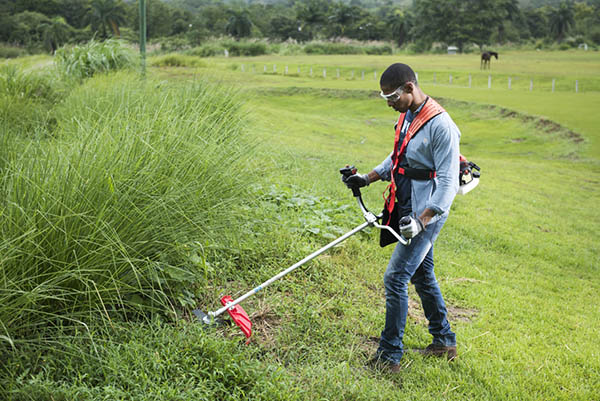
LATEST NEWS BY CRAFTOP

LATEST NEWS BY CRAFTOP
There are a number of safety aspects to consider when using a brushcutter. Here is an overview of how to dress in order not to get injured, and how to operate the machine efficiently.
Preparations
Always wear a visor, safety glasses and hearing protection when clearing, or a safety helmet with visor and hearing protection if the stand reaches head height. Shoes, protective footwear or strong boots should always be worn.
In dense stands you should wear heavy-duty clothing. When clearing brush and grass, heavy-duty trousers and a shirt or jacket will generally be sufficient.
Read more about safety equipment in our article “Brushcutters and personal safety.”
The harness and anti-vibration system
The design and individual adjustment options of the harness play a crucial role. The harness distributes the machine’s weight so that the body is not put under unnecessary strain. Therefore the harness should not hang loosely, but sit tight against the body. The machine’s suspension point should also be adjusted so that you obtain the correct working angle to the ground.
There are also several other fixing points on the machine, partly so the cutting equipment works parallel to the ground and partly so the machine is correctly balanced.
Most brushcutters are equipped with vibration damping between the engine and shaft. However, as soon as the cutting equipment starts to bite, other vibrations and types of impact occur. To overcome this, NEWTOP has developed a unique anti-vibration system. The whole of the upper section with the handle and the section that rests against the body is isolated from the engine and shaft. NEWTOP also has a full anti-vibration system on machines fitted with loop handles.
Starting point
The ideal starting point when using a brushcutter is this: A straight back, the hands extended comfortably in front of you and the cutting equipment directly in front of the body.
As NEWTOP brushcutters have an angle between the double handle and the shaft, offset 7 degrees to the left, a left-hand sweep is not obstructed by the body and handle colliding. It is this, which allows you to effectively sweep in both directions, without excessive twisting of the back.
Each type of vegetation requires its own clearing technique. On this website you will find easy-to-follow how-to articles on clearing thick grass, plain grass, and coarse brush and bushes.
